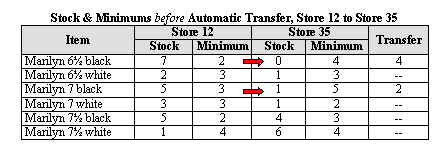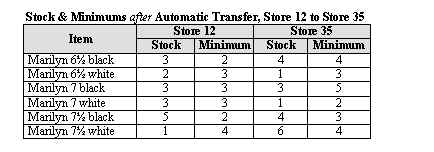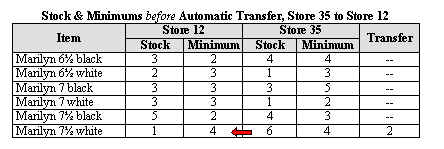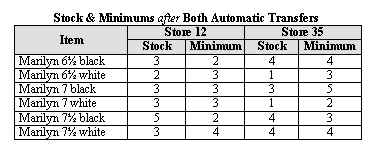 |
What's New | Why Inventory Control | Reports | Comparisons | Contact Us |
| Smarter Retail | Why XpertMart | About the System | Size/Color Matirx | Support |
 How
to Make Half A Million Decisions a Week
How
to Make Half A Million Decisions a Week
 Using
Minimums with No Sales History
Using
Minimums with No Sales History
 Minimums
Are Still Useful Even Without Recurring Purchases
Minimums
Are Still Useful Even Without Recurring Purchases
 Using
Maximums to Control Your Supply Chain
Using
Maximums to Control Your Supply Chain
Optimizing Inventory with XpertMartTM
Use Automatic Transfers to Balance Inventory
Minimums & Maximums are most useful when it comes to purchasing merchandise and distributing that merchandise from a central warehouse to the stores. As we’ve mentioned, a chain of 40 stores has to deal with half a million stocking decisions to keep its operation running. There is simply no way to make these decisions correctly without automation. The better a retailer becomes at using Minimums & Maximums to control purchasing and distribution, the fewer inter-store transfer he will have to make. Of course no distribution system can reduce the margin of error completely (customers are, after all, highly unpredictable) so it becomes necessary to use Automatic Transfers to fully optimize inventory.The final step in achieving optimal inventory is balance, or distributing existing stock among your stores in order to maximize sales. No two stores will ever have identical sales. Even assuming that two stores are in the same economic zone and serve the same demographic base, one manager may decide to highlight a certain style of boot in the display window while the other one doesn’t, or one store may have an outstanding saleswoman who really knows how to push tennis shoes while another store may have someone who is very good at selling handbags. In most cases, however, economic and demographic factors are enough to create major differences in the sales patterns of different stores. The goal of the retailer, even after every effort has been made to only purchase the stock that is needed, is to constantly monitor sales and move merchandise to where it replenishes a sale that has been made. We do this through Automatic Transfers.

XpertMartTM allows you to balance inventory between any two stores. You can select, for example, Store #12 and Store #35, and ask the system to create Automatic Transfers between these two stores. XpertMartTM will look for items in Store 12 that are above their Minimum and below their Minimum for Store 35 and transfer enough items to cover the Minimum. However, an Automatic Transfer will never ship items out if it will cause the stock of that item to fall below its Minimum. In the table above, there are several examples that illustrate these rules. In the first item in the table, the Marilyn 6½ black dress sandal, XpertMartTM will transfer out 4 pairs from Store 12, where it is overstocked, to store 35, where it is understocked. Notice that only 4 pairs are sent out and not 5, because only 4 additional pairs are needed for Store 35 to cover its Minimum. In the second example, no pairs of the Marilyn 6½ white sandal are shipped out because Store 12’s stock is below its Minimum and therefore cannot afford to send items to Store 35. Similarly, in the third example, only 2 pairs of the Marilyn size 7 black sandal are shipped out to Store 35, because to send any more would mean Store 12 is understocked as is the case with the next example, the size 7 white sandal. In the last two cases, no transfer is necessary, as Store 35 is overstocked. The new stock levels after the transfers are complete are shown in the table below.


Let’s examine what these transfers have done to our inventory. Prior to the Automatic Transfers, we had a total of 36 items in stock between the two stores (for the 6 size & color combinations shown above). Of these 36 items, 15 were overstocked, i.e. over their Minimum—that’s over 40%. Furthermore, we were also understocked by 15 items. Definitely sub-optimal inventory in both cases. Now, of a total of 12 possible supply decisions (6 size/color combinations * 2 stores), the system took 3 supply actions, transferring a total of 8 items. We still have a total of 36 items, only this time, we are only overstocked by 5 items. With these three simple transfers, our excess inventory dropped from over 41% to just under 14%. Similarly, we are now only understocked by 7 items instead of 15 so that our merchandise shortage as dropped form over 41% to just under 20%. As we can see from this example, a little bit of fine-tuning can yield major improvements in our inventory optimization. This example took place in a total universe of 12 supply decisions—now imagine the consequences in a total universe of 500,000 supply decisions!

Some retailers are afraid of using automation to manage their distribution system because they are afraid of losing control over their operation. The nightmare scenario is trucks full of merchandise crisscrossing the country on some computer’s orders. The fear is unfounded. XpertMartTM will always give the user the opportunity to review every Transfer Order before it is executed. This way the user has complete freedom to edit or veto any Transfer Order the system generates. Automatic Transfer Orders are really Automatic Transfer Suggestions, in this regard. All XpertMartTM is doing at this point is simplifying the decision-making process by concentrating the right data in the hands of the user.
You will never appreciate all the little cases of “one blue pair of this in size 7 and one pair of those in brown size 8.5” the system will “pull up” and how impossible it would be to do this by hand until you actually have one of these suggested transfer reports in your hands. You may think this document has taken too much time over-analyzing one pair of style ABC in blue at store 42. This may seem absurd as you would never have the time to do this analysis. The point here is that all you have to do is set the criteria and XpertMartTM whizzes through the 500,000 or 2,000,000 decisions and makes them for you. When you see all of the items that need to be transferred and look the sale prices totals on the report, you will see how XpertMartTM pays for itself.
Probably the most dramatic case we have ever seen was with a client of ours, a chain of 30 shoe stores. The year before they started working with us, store managers set Minimums manually; in other words, they were in no way based on actual sales trends. Once we helped them automate their chain, the software began calculating and re-calculating Minimums based on actual sales. On a Saturday night, five days before Christmas, we realized that each of their 30 stores had, on average, sold 50% of its stock during this peak season. Store managers were able to restock their stores by the following Monday morning without consulting senior management, solely based on Minimums. This way their stores optimized their inventory in time to take advantage of the 2½ days left before Christmas. Managers later told us that “it’s as if we had two holiday seasons that year!”
Copyright © 2002 XpertMart